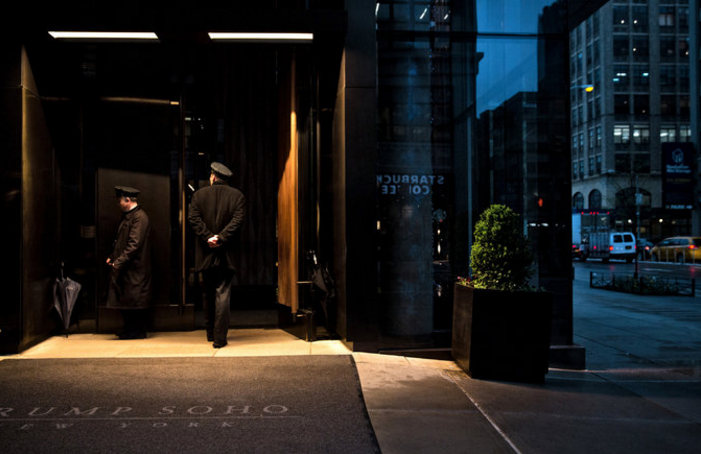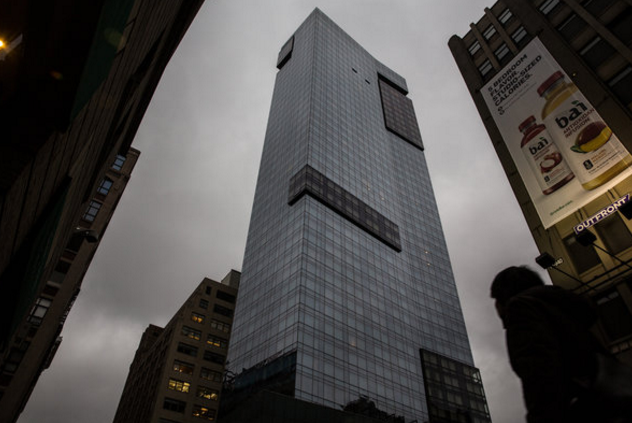Donald Trump Settled a Real Estate Lawsuit
By Mike McIntire
April 5, 2016
For Donald Trump, it is a long-held legal strategy, if not a point of pride, to avoid knuckling under to plaintiffs in court.
“I don’t settle lawsuits — very rare — because once you settle lawsuits, everybody sues you,” he said recently.
But Mr. Trump made an exception when buyers of units in Trump SoHo, a 46-story luxury condominium-hotel in Lower Manhattan, asserted that they had been defrauded by inflated claims made by Mr. Trump, his children and others of brisk sales in the struggling project. He and his co-defendants settled the case in November 2011, agreeing to refund 90 percent of $3.16 million in deposits, while admitting no wrongdoing.
The backdrop to that unusual denouement was a gathering legal storm that threatened to cast a harsh light on how he did business.
Trump SoHo is one of several instances in which Mr. Trump’s boastfulness — a hallmark of his career and his campaign — has been accused of crossing the line into fraud. Other lawsuits have charged that he peddled worthless real estate sales courses and misled investors into thinking he had built hotels when in fact he had only licensed his name to them. He has won several cases at trial and is continuing to fight others.
When Mr. Trump and his co-defendants made the decision to settle the condo buyers’ lawsuit in 2011, it was a far cry from the heady days of 2006, when Mr. Trump closed an episode of his hit television show “The Apprentice” with a splashy plug for Trump SoHo. In typical Trump fashion, he piled on the plaudits for “my latest development.”
“When it’s completed in 2008,” he said, “this brilliant $370 million work of art will be an awe-inspiring masterpiece.”
…
Slowing Sales and a Lawsuit
The official unveiling of Trump SoHo in September 2007 was quintessential Trump: a red-carpet announcement followed by a big bash, where flavored vodka flowed, dancers whirled and models wandered about. Amid the hoopla, Mr. Trump took the microphone to extol the greatness of the project. Standing beside him, beaming, were Mr. Arif and Mr. Sater.
The timing of Trump SoHo’s completion and marketing could hardly have been worse. The real estate bubble was bursting, and the global economy was on the brink of crisis as the developers began advertising luxury condo-hotel units costing as much as tens of millions of dollars.
The economics of the investment were largely untested in New York real estate. To get around residential zoning restrictions, owners of Trump SoHo units were allowed to live in them only 120 days a year. The rest of the time, the units would be rented as hotel rooms, with the owners sharing in the revenue.
The project was marketed aggressively to potential investors overseas, where exchange rates were favorable and the Trump brand carried a certain cachet. Many early buyers were from Europe, including a French former soccer star, Olivier Dacourt, who put down a deposit of $460,400 on a $2.3 million unit.
After an initial flurry of activity, the pace of sales slowed considerably. In addition to the economic decline, Trump SoHo was jolted by bad publicity when The New York Times published an article in December 2007 revealing Mr. Sater’s criminal past.
According to data the Trump SoHo developers filed with state and federal agencies, only 15 to 30 percent of the units had been sold by the start of 2009. But those numbers did not come close to the grand-sounding sales figures promoted, publicly and in private, by people affiliated with Trump SoHo, according to a lawsuit filed in August 2010 by Mr. Dacourt and other people who had bought units.
In June 2008, Mr. Trump’s daughter Ivanka was quoted in a Reuters article saying that about 60 percent of the units had been sold. In April 2009, Mr. Trump’s son Donald Jr. appeared in another news articlesaying that 55 percent of the units were sold by March of that year. More purported cases of puffery occurred in emails and statements by sales agents.
The lawsuit also suggested that Mr. Trump had contributed to the deception, citing a claim he made at the project’s unveiling. Depending on the news account, he said 3,200 prospective purchasers either had signed up to see the units or had requested applications to buy them; the plaintiffs argued that this figure was exaggerated, given how few units had actually been sold at the time. The Trumps and the other defendants denied that there had been any deception.
The inflated numbers were more than just harmless self-promotion and amounted to fraudulent enticement of investors, who believed they were buying into a project that was healthier than it actually was, said Adam Leitman Bailey, the lawyer representing the buyers.
“They relied on these misrepresentations to their detriment,” he said.
…
The next year, when it was clear that Mr. Bailey’s lawsuit would be allowed to proceed, Mr. Trump and his co-defendants agreed to settle the condo buyers’ suit. The financial terms were announced publicly, but another part of the settlement was kept secret.
…
As for Trump SoHo, the condo-hotel concept did not pan out. Only about a third of the units were ultimately sold, and one of the project’s lenders foreclosed on the rest, although the property remained open and became a popular luxury hotel, still managed by Mr. Trump’s company.


